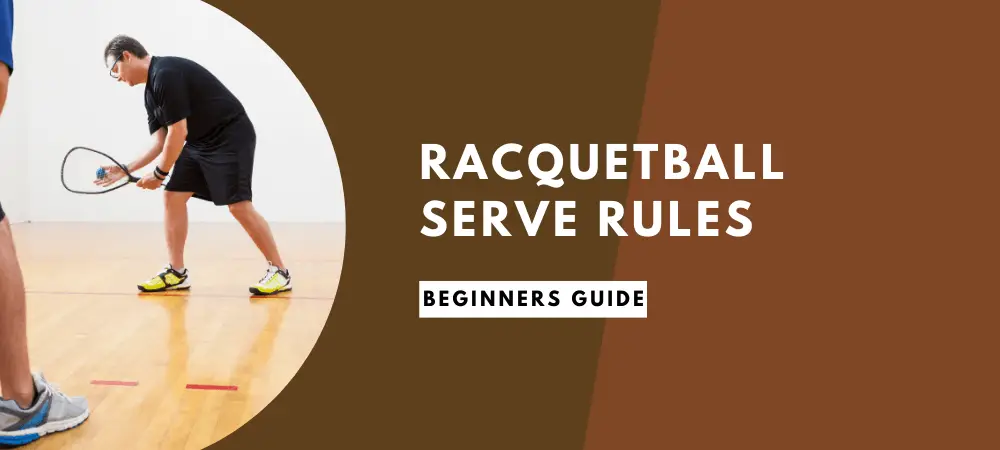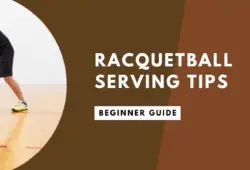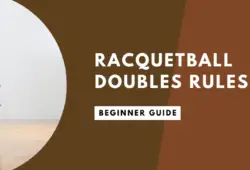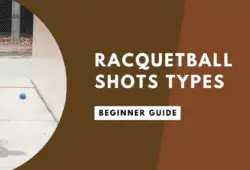Racquetball has many types of serves on the forehand and backhand hits. You can play drive serves that are low and hard or lob serves which are high and gentle. Generally, you use the drive type for the first serve in a game, followed by lob serves.
However, there are some racquetball serve rules to respect.
So the questions here is: what are the serving rules in racquetball?
In this article, we introduce you to some of the basic and most important rules that govern the different types of serves.
Let’s get started.
Table of Contents
Main Basic Serve Rules In Racquetball
The service zone: It has a dimension of 20-feet width X 5-feet length. It is located between the short-line and service-line along the court length. A screen line and doubles box are on the left and right side of the court along the width. The server has to stand within the service zone.
Standing Posture: You have to stand to face the left or right sidewall of the court with reference to the service line (depending on you are left handed or right handed). Your legs should be spread a little wider than shoulder width. Bend your knees to 130-degrees and waist to 140-degrees. Hold the racquet at waist height. Your face should be towards the front wall.
First, serve: The player who wins the coin toss gets to serve in the first game. The player with maximum points in the first game gets to serve in the next game. It remains the same for the three games. If the scores are tied in the first game, there will be another coin toss in the next game.
| # | Preview | Product | Rating | |
|---|---|---|---|---|
| 1 |
|
HEAD MX Fire 190 Beginners Racquetball Racket - Pre-Strung Head Light Balance Racquet,Navy/Orange | 366 Reviews | Check today's price |
Serve Shot: You have to bounce the ball on the floor and hit it against the front wall. The returning ball has to bounce within the service zone. It should not hit the ceiling or the back wall. The server should have at least one foot within the service zone without hindering the receiver until the served ball crosses the short-line and the receiver hits it.
Serve-Delay: If the server fails to serve the ball until 10 seconds of the referee signal, it is considered as serve delay.
Receiver Not-Ready: The server may serve the ball before the receiver is ready. It is the fault and the referee shall order for a re-serve.
Drive Serves: The drive serves should happen within the screen line which has a length of 3 feet from the side wall on left and right. In case of the doubles game, the server has to stay within the doubles box for the drive serves.
Other Serves: The drive serve rule doesn’t apply for other serves like the lob, half-lob, soft-z, hard-z, and cross-court.
Faulty Serves In Racquetball
3-Wall-Serve: If the served ball hits the two side walls after hitting the front wall and before touching the floor, it is considered as a 3-wall serve which is a fault. The player has to re-serve the ball.
Foot-Fault: If the server moves out of the service-zone before the served ball crosses the short-line, it is a fault. If both the feet are not within the service-zone while starting the service-motion, it is also a fault.
Out-Of-Court: If the ball goes out of the 40-feet X 20Feet court, it is considered to be out of court serve. Any hit to the surface outside the playing area is also out of court serve.
First Hit: If the server fails to hit the front wall first then it is called non-front-wall serve and it is a fault.
| # | Preview | Product | Rating | |
|---|---|---|---|---|
| 1 |
|
Penn Racquetballs (Pack of 12), Blue | Check today's price |
Fake Serve: The servers’ racquet should move away from the ball after serving. If there is any deliberate attempt to block the receiver’s view after serving, it will be considered as a fake server. The referee may impose a penalty.
Long-Serve: If the served ball hits the back wall after hitting the front wall before touching the floor, it is a long serve. The player has to re-serve the ball.
Short-Serve: if the served ball hits the floor before the service line or before crossing the short-line, it is called Short-serve. The player has to re-serve the ball.
Penalty-Hinder: The server is considered to be penalty hinder in any of the following cases. The ball hits the receiver’s body. The server makes physical contact with the receiver and hinders his returning ability. The ball returns in a ransom manner after hitting the front wall. The referee can decide about the penalty, depending on the intention of the server.
When Does Service Chance Happen?
Change in serve will happen when there are two continuous service faults. It can also happen at the end of the first game if the receiver has more points than the first server. The other occasions are penalty hinder, side out missed rally, and out serve.
What’s Next?
In this article, we have introduced you the basic and the most important rules of the racquetball serve. You can get to know about their practical implications when you start playing the game on the court with your opponent. Make sure you avoid the faults in service through continuous practice.
And also make sure to check the official rules document from the USAR so that you can have a wide understanding of how racquetball is played.
Let me know below in the comments in case you have any questions related to serving rules in racquetball.




